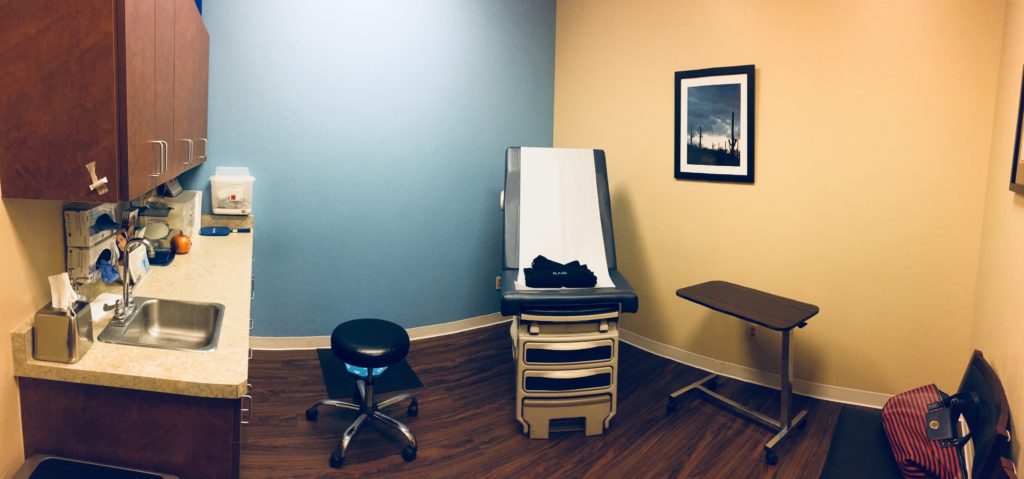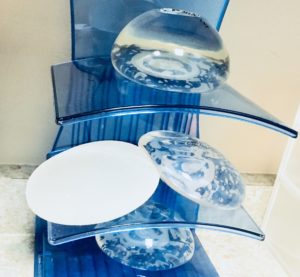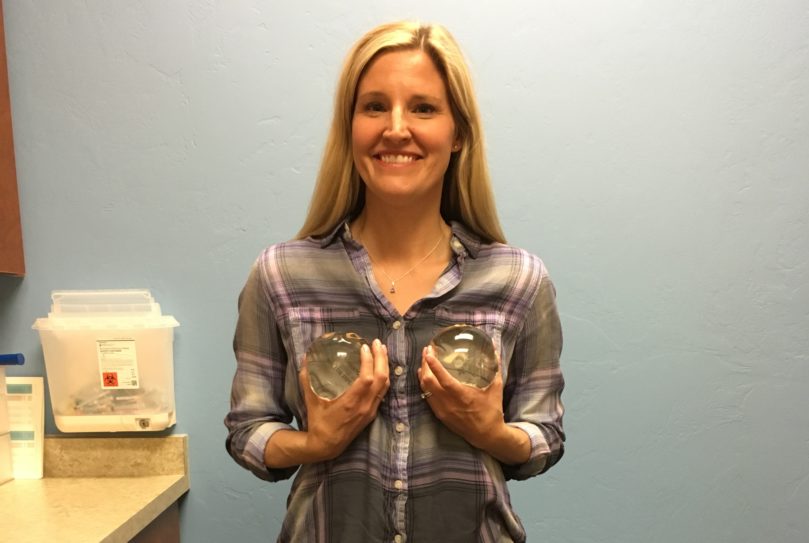Ok so my title gives it all away, but when I received my pathology results from my lumpectomy, the suspicious cells were in fact cancer. DCIS, just as my initial pathology report alluded. I met with my breast surgeon twelves days after my lumpectomy for my post-opp appointment and to review my pathology report. My husband was out of town on business, but I was so anxious to get answers I kept the appointment regardless. That was the first appointment he missed.
The goal of the lumpectomy was to determine if the cells were in fact cancerous, to remove all the cancerous cells and to attain “clear margins.” Clear Margins are simply cancer-free normal tissue surrounding the cancerous cells. This assures all the cancer is removed. I did not have clear margins. Meaning there were still cancerous cells surrounding the area of cancer cells the surgeon removed. Essentially the cancerous cells had a larger footprint than anticipated.
The surgeon told me I had to have another lumpectomy to remove more tissue and attain clear margins. Following this second lumpectomy, I would also need to undergo radiation and five years of hormone therapy. She was brutally honest with me. She warned me, being pre-menopausal, the hormone therapy would be a game changer. Essentially, I would get to experience all the unpleasant side effects of menopause without actually going through menopause. Sounds like fun! Chemotherapy was not even a consideration, because the cancer had not spread.
That is when I brought up the option of a mastectomy. She told me it was a more aggressive treatment option, but an option nonetheless. Based upon my extensive research (remember all that “spare” time I had to read while waiting for my initial appointment?), I was interested in a nipple-sparing bilateral mastectomy with immediate reconstruction. That is the technical term for removing the breast tissue in both breasts but keeping the nipples. Nipples are technically breast tissue, but the thought behind sparing them is that you get to keep the natural appearance of your breasts. Since the nipples are superficial, any changes are likely to be detected fairly quickly too. Nipple sparing also depends upon the location of the cancer. Luckily mine was far enough away from the nipple nipple sparing was an option.
Immediate reconstruction sounds more immediate than it actually is. Immediate simply means the reconstruction process begins at the time of the mastectomy. After the breast surgeon removes all the breast tissue, the plastic surgeon inserts expanders behind the pectoral muscles. The expanders are then slowly filled with a salt water solution over time to stretch the pectoral muscles (we are talking weeks or months). Once the desired size is reached, the expanders are surgically removed and replaced with permanent implants.
Another major consideration for me when it came to a mastectomy was my age. I was 37 when I was “officially” diagnosed with breast cancer. Less than 7% of breast cancers occur in women under age 40, this age group has the worst survival rate.3 Another factor working against me was the possibility of recurrence. The younger you are at the age of diagnosis, the higher your odds of recurrence. This seems logical since theoretically, you have more years to live post-diagnosis and more years for breast cancer to develop again. Based upon one study I had between a 20-83% chance of recurrence if I chose a lumpectomy and radiation for my treatment.1 My initial Tyrer-Cuzick Risk was 29.1% (which in reality turned out to be 100% since I did develop cancer). Comparing my 29.1% risk to 20-83% risk, I felt like eliminating this possibility was extremely appealing, logical and would also eliminate future worry.
Based upon my research too, choosing a lumpectomy with radiation limited my future options should I experience recurrence. Radiation, in particular, damages the tissue’s elasticity and ability to heal, thus limiting future reconstruction post mastectomy (Link, 66). Given my high odds for recurrence, I did not want my options to be limited in the future. A bilateral nipple sparing mastectomy seemed to pose the greatest success for not only eliminating recurrence but getting aesthetically pleasing results too.
I asked my surgeon what she would choose in my situation. She told me she couldn’t say, but she could tell me I would never regret a mastectomy. I could end up regretting only doing a lumpectomy, radiation and hormone therapy. She said given the fact my breast cancer was not genetic, it was a “fluke.” However, she has seen women with multiple “flukes.”
If I chose a lumpectomy with radiation, a radiation oncologist would oversee my radiation treatment. If I chose a mastectomy, a plastic surgeon would be responsible for reconstruction. I asked for referrals to both to further weigh my options. My breast surgeon also gave me two pamphlets from Susan G. Komen for the Cure – “What I can do to take care of me” & “What’s Happening to Mom? Talking to your Children about breast cancer.” I was appreciative for the resources.
Both doctors to whom I was referred followed up with scheduling promptly. I met with the plastic surgeon two days later and the radiation oncologist six days later. My husband was still out of town for business when I met the plastic surgeon. I am going to be completely honest and admit, I had never been more intimidated about meeting with a doctor in my life. I had never imagined myself having a plastic surgeon.
I had no idea plastic surgeons did anything other than elective procedures. I assumed going into his office I would be surrounded by perfect models hoping to become even more perfect. Much to my relief I was alone in the lobby initially. However, I was joined by an elderly woman shortly after my arrival who chose the seat next to me in an otherwise empty waiting room and struck up a conversation. Her conversation set my nerves at ease. She began to tell me she had just had a breast reduction and had three pounds removed from each breast. “Two bags of oranges!” as she put it. She lamented why she had waited so long to do the procedure and how she felt like a new woman. I found her wiliness to share this with me, a total stranger, and the manner she shared comical.

The plastic surgeon was friendly. He took his time to answer all my questions without making me feel rushed or like I was wasting his time. I openly discussed with him that I was considering all my options and I would be meeting with the radiation oncologist as well. His response to that statement was:
If you were my wife or sister I would encourage you to have a mastectomy.
I am used to doctor’s using the phrase “If you were my daughter…” not “my wife or sister!” Am I that old or was he that young?! I guess yes to both. I am now old enough to be around the same age as my doctor.
Now to what seemed awkward at the time, but not so much anymore. He took measurements of my breasts and photographs. I can honestly say now, because of this process, my breasts are thoroughly documented. He smiled when he saw the placement of the scar from my lumpectomy and commented that my breast surgeon does good work. As he took measurements, I commented that I had breastfed three children. I assumed that had adversely affected my breasts. He paused and immediately responded,
Your measurements are great. They don’t reflect that at all.
Great! I was looking for a silver lining. He could have agreed and told me he was going to fix them, but he didn’t. Instead he explained how a reconstructed breast would never be as nice as a natural one. This seemed exactly the opposite of what I would expect. Wouldn’t fake be more perfect? I was still looking for a silver lining and skeptical of his comment. I understand now what he was referring to. I am incredibly happy with my results, but they are definitely not the same as natural breasts. We discussed all the risks of a mastectomy with reconstruction.

Something he and my breast surgeon both mentioned was the possibility of necrosis. Necrosis is the dying of your skin and/or tissue. My breast surgeon said it had never happened to any of her patients before, but there is always a risk. She said skin discoloration would be much more likely. The plastic surgeon did not tell me he had never had it happen to a patient before, but I also got the impression it wasn’t that common. Both told me the risk of necrosis is worse the smaller you are because you have less tissue remaining after the breast tissue is removed.
Since my husband was out of town for both appointments, he was eager to learn of all that had transpired. The problem? He was at a remote jobsite. Communications were very limited. Maybe purely because he wanted to hear every word I was saying, but our phone conversations were terrible. He could not hear every other word and quickly became frustrated trying to understand me. I did my best to email him information, but I realized that it was probably a mistake to press ahead while he was away when he so clearly wanted to be involved.
Luckily my appointment with the radiation oncologist was after his return. Entering and waiting in the lobby at the oncologist’s office was an experience in and of itself. I was hands down the youngest person there by decades. Many of the patients waiting bore the physical manifestations of their battle with cancer – scarves covering their heads and exhaustion as a result of the chemo ravaging their bodies. Their condition seemed far worse than my own, yet I felt their eyes upon me. When I met their gaze it was with a look of sympathy and bewilderment that I should be sitting there too. My age made me strangely out of place and I was acutely aware of it too.
Any earlier communication frustrations were quickly laid to rest by the radiation oncologist. She sat down with both of us and explained my lumpectomy pathology report more thoroughly that anyone had thus far. She drew pictures to further explain how cancer grows and why my breast surgeon did not achieve clear margins, even though she extracted an area of tissue twice as large as the initial area of concern.
I was upfront with the radiation oncologist about exploring all my options. I told her I had met with the plastic surgeon to discuss a double mastectomy. She then asked me a series of questions. After I answered all of her questions she gave me her opinion. She told me looking at my initial mammogram and my MRI images, the mammogram should have shown the DCIS. Given that, she told me she had little to no faith in preventative screening moving forward. She told me she would recommend a double mastectomy. It wasn’t a recommendation that benefited her. She was eliminating the need for her services, but it was what she felt would be best for me.
My husband had been concerned about the age of the plastic surgeon I met with. He had been wondering if an older more experienced surgeon would be better. He brought this up with the radiation oncologist. She asked with whom I had met, assuring me he was one of the best. I would later have a similar conversation with my breast surgeon. She agreed. She told me she could refer me to someone with “grey hair,” but that the results and the care would not be as good.
I finally decided to move forward with a bilateral nipple-sparing mastectomy. I made the decision in early December, but my surgery was not scheduled until the end of January. Finding a date where both surgeons were available for such a long procedure was a challenge, especially with the holidays. Aside from finding an opening in both surgeons’ schedules, scheduling was also hampered by office closures and OR closures for holidays.
- Link M.D., John. The Breast Cancer Survival Manual. Fifth Edition. Owl Books, 2012.
- “Younger Women More Likely to Have DCIS Recurrence.” October 12, 2009. http://www.breastcancer.org/research-news/20091012
- “Do Young Women Have Worse Breast Cancer Outcomes? It Seems to Depend on the Cancer’s Characteristics” August 5, 2016. https://www.breastcancer.org/research-news/do-young-women-have-worse-outcomes
